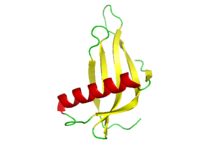Monellin
| Monellin Chain A and B | |
|---|---|

X-ray crystal structure of a single-chain monellin protein.
|
|
| Identifiers | |
| Symbol | MNEI |
| PDB | 2O9U More structures |
| UniProt | P02882 |
Monellin, a sweet protein, was discovered in 1969 in the fruit of the West African shrub known as serendipity berry (Dioscoreophyllum cumminsii); it was first reported as a carbohydrate. The protein was named in 1972 after the Monell Chemical Senses Center in Philadelphia, U.S.A., where it was isolated and characterized.
So far, five high-intensity sweet proteins have been reported: monellin (1969), thaumatin (1972), pentadin (1989), mabinlin (1983) and brazzein (1994).
Monellin's molecular weight is 10.7 kDa. It has two noncovalently associated polypeptide chains: an A chain sequence with 44 amino acid residues, and a B chain with 50 residues.
Monellin chain A (44 AA):
REIKGYEYQL YVYASDKLFR ADISEDYKTR GRKLLRFNGP VPPP
Monellin chain B (50 AA):
GEWEIIDIGP FTQNLGKFAV DEENKIGQYG RLTFNKVIRP CMKKTIYEEN
Monellin has a secondary structure consisting of five beta-strands that form an antiparallel beta-sheet and a 17-residue alpha-helix.
In its natural form, monellin is composed of two chains (A and B, of 44 and 50 amino acids as shown above), but is unstable at high temperatures or at extremes of pH. To enhance its stability, single-chain monellin proteins were created in which the two natural chains are joined via a Gly-Phe dipeptide linker. This modified version of the protein (MNEI) has been studied using NMR and X-ray diffraction.
The image displayed on this page shows the structure of monellin derived from X-ray diffraction at a 1.15 ångström resolution. The high resolution used to obtain the structure provided a more detailed look at monellin and its properties than previously possible.
In addition to its secondary structure, four stably bound sulfate ions were located on the monellin protein, three on the concave face of the protein and one on the convex face of the protein. The sulfate ion on the convex face of the protein is of particular interest because it lies adjacent to a patch of positive surface potential, which may be important in electrostatic interactions with the negative T1R2-T1R3 sweet taste protein receptor.
...
Wikipedia
